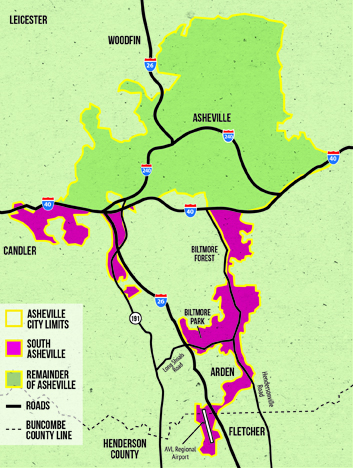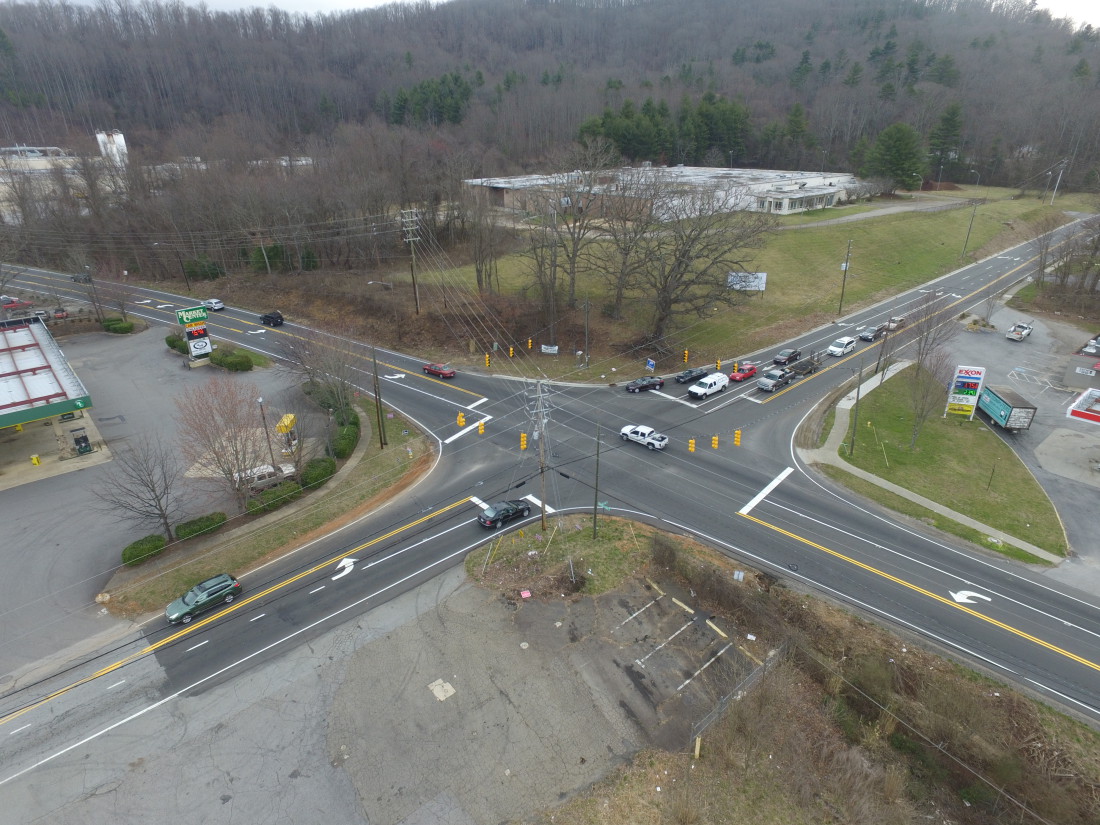When retired educator Pat Deck attended a meeting of the city’s Neighborhood Advisory Committee last September, she remembers, “A light bulb came on.” Deck has lived at Givens Estates off Sweeten Creek Road for the last 10 years, but it was only then that she realized “We don’t have a voice in city government.”
Former Asheville Mayor Ken Michalove, who was running for City Council at the time, made the same point at the meeting, saying South Asheville is underrepresented both in terms of elected officials and appointees to boards and commissions.

According to Marsha Stickford, the city’s neighborhood coordinator, South Asheville encompasses those parts of the city lying south of Interstate 40. A look at the map helps explain why the area has been overlooked and has lacked a cohesive identity: The city boundaries snake irregularly south along major arteries, and the resulting patchwork of diverse communities ranges from Shiloh to Givens to Biltmore Park (see sidebar, “Welcome to the Neighborhood”).
Despite wide variations in income levels, however, many residents are prosperous. Heidi Reiber, director of research for the Asheville Area Chamber of Commerce, says that while she can’t isolate the stats for South Asheville, South Buncombe’s average household income is $74,805, compared with $61,829 for the city as a whole.
And Deck, a longtime political activist who serves on the board of directors of the League of Women Voters of Asheville-Buncombe County, says she left the September meeting with a new mission: organizing South Asheville residents to call attention to concerns facing the rapidly growing area.
Come together
Asheville attorney Corey Atkins lives in Ballantree. Part of the reason he ran for City Council last fall, he says, was “a sense that South Asheville is disconnected from the rest of the city. Despite being the fastest-growing part of the city and having a large tax base, Atkins explains, “South Asheville residents have felt left out of city processes, especially with regard to development.” Although his Council bid fell short, Atkins is continuing his efforts to organize the community, both as the local Democratic Party’s leader for Precinct 29.2 and by building lines of communication throughout the various areas.
South Asheville resident Ed Hay is a candidate for Buncombe County commissioner in District 3. The Democrat will face incumbent Joe Belcher in November. Hay served on City Council from 1995 to 2001, while Dr. Joe Dunn sat on Council from 2001 to 2005. Patsy Keever served three terms on the Board of Commissioners from 1992 to 2004. Both Dunn and Keever live in the Ballantree neighborhood off Sweeten Creek Road. Since 2005, there’ve been no city or county elected officials from the area.
“I’m not sure why South Asheville has traditionally been underrepresented in local government,” says Hay. “Maybe it’s because most of the people moving into the area are coming here from other places.”
And while Atkins concedes that “There isn’t a lot of cohesiveness between the Sweeten Creek corridor and areas like Biltmore Park,” he believes they share many common concerns. One obstacle, he says, is the lack of a central gathering place. “The South Buncombe Library has limited space,” Atkins explains. “The Skyland Fire Station also hosts some community meetings, but south of the Parkway, no true community center exists.”
Deck got around that problem by hosting a Feb. 16 meeting of Sweeten Creek Road homeowners at Givens Estates’ Performing Arts Center, saying she was “thrilled” when about 20 representatives of different homeowner associations showed up.
“This is a wonderful opportunity for our neighborhoods to work together,” says Deck. “Now we’re trying to find our voice to advocate for reasonable, sustainable neighborhoods. We’re concerned about issues like controlling traffic congestion and expanding greenways. We’re worried that some of the qualities that attracted us to this area originally seem to be getting lost through the pace of development and change.”
Right now, her group is focusing on preparing individual neighborhood plans for inclusion in Asheville’s comprehensive plan, which is being updated this year. She and fellow Givens Estates resident Becky Anderson, a former director of economic development for the city, are reaching out to Biltmore Park as well as neighborhoods along Hendersonville and Long Shoals roads to involve those residents in the planning effort.
A controversial proposal
Fledgling organizational efforts had already gotten underway when a proposal for a new project poured fuel on the fire.
On Oct. 19, the city’s Technical Review Committee approved developer Rusty Pulliam’s plans to build 252 apartment units and three commercial buildings on the former Plasticorp site at the corner of Sweeten Creek and Mills Gap roads. Pulliam Properties, the company he runs, was founded by his father, the late Winston Pulliam. It’s been involved in many of the projects that have shaped the Hendersonville Road corridor, including the Dingle Creek Crossing shopping center, the Weirbridge Village apartment complex, Southern Community Bank and Trust, HomeTrust Bank, Panera Bread and the Forest Edge shopping center.
The Planning and Zoning Commission first considered Pulliam’s project on Nov. 19, and both city staff and residents had plenty to say about the plans.
Urban planner Vaidila Satvika introduced the project. After laying out the details and the zoning considerations, Satvika explained that the city has established goals for retaining industrial properties like this one. Rezoning this parcel, he said, would diminish the city’s already limited stock of viable industrial sites while hurting efforts to create more jobs and attract capital investment in the manufacturing sector.
Furthermore, he continued, “Staff believes the site is not a suitable location for residential development due to the lack of sidewalks and transit service, as well as the high traffic volumes.” Since 2013, he pointed out, the city has approved the construction of over 800 units of residential housing within a 2-mile radius of the site.
After a lengthy discussion in which a number of residents spoke out against the plan, Pulliam’s attorney, Lou Bissette, asked that the project be withdrawn without a vote.
The commission reviewed it again on Jan. 6, and Ballantree resident Vijay Kapoor presented a letter signed by 371 South Asheville residents asking the commissioners to reject the proposal.
Kapoor is a co-founder of the South Asheville Resident & Business Community Organization, formed in response to Pulliam’s proposal. Residents, he says, already had plenty of concerns about congestion and the blazing pace of new construction, but their frustration lacked a specific focus. The Plasticorp project galvanized them to organize and lobby City Council to deny the necessary zoning change.
The group’s Jan. 6 letter described the traffic volumes residents say they regularly experience at the intersection of Sweeten Creek and Mills Gap roads. “According to the 2014 N.C. DOT traffic volume analysis, Sweeten Creek Road north of Mills Gap Road handles 18,000 vehicles per day, despite being only two lanes,” the organization explained. “By contrast, Merrimon Avenue north of Chestnut Street (Trader Joe’s/Harris Teeter) handles 20,000 vehicles per day with four lanes.” Approving Pulliam’s project, the letter continued, would be tantamount to restricting Merrimon Avenue to two lanes while adding a major new apartment complex to the busy corridor.
Back to the drawing board
At the Jan. 6 meeting, Pulliam announced that he’d revised the proposal, removing the commercial components, bumping up the number of units to 272, and adding a commitment to designate 20 percent of them as affordable housing for 10 years. Bissette, who’s also a former Asheville mayor, challenged the city’s argument that the site should be retained for industrial use, citing a letter from Ben Teague, executive director of the Economic Development Coalition, to Sam Powers, the city’s director of economic development. “I do not believe this property is best suited for industrial development,” wrote Teague, adding, “While I suggest a positive vote in this case … we must preserve viable industrial property when possible.”
This time, the commission voted 6-1 in favor of the project, with landscape architect Guillermo Rodriguez casting the dissenting vote.
With P&Z’s recommendation in hand, Pulliam requested a public hearing, which was scheduled for the Jan. 26 City Council meeting. But continued fierce public opposition to the project led him to ask that the hearing be postponed; it’s now slated for April 26. The developer has since requested another postponement to June 14, but City Council hasn’t yet approved that.
Meanwhile, Pulliam has redoubled his efforts to convince residents that his apartment complex wouldn’t increase traffic congestion and would be the least disruptive use of the site.
Boxed in

On Feb. 29, Pulliam hosted a community meeting at the Skyland Fire Station. About 60 people attended, including Council members Julie Mayfield and Gordon Smith, state Rep. Brian Turner, county commissioner candidate Hay (who lives close to the project site) and Stickford.
Pulliam kicked off the discussion with some updates. He committed to delaying construction until 2018, with completion set for mid-2020. The timing, he said, would be a good fit with the Department of Transportation’s plans to widen Sweeten Creek Road in 2021.
Pulliam also announced that he now plans to set aside 15 percent of the units as affordable for 15 years — in other words, fewer units for a longer period of time. “I will be the first to give either of those — 15 percent or 15 years — in the city,” he pointed out. He later explained that the change was made to address Council members’ concerns.
“Asheville,” Pulliam asserted at the meeting, “is in a housing crisis, not an industrial property crisis.” And one way or another, someone will develop that land.
James Voso, a local traffic engineer hired by Pulliam, outlined the traffic mitigation plans. “This is a congested area,” he conceded. “We do not deny that. There are periods of the day when traffic is bad.” Nonetheless, he went on, the developer’s responsibility is to address the impact of the proposed project, not the overall traffic situation. “We’re not in a position to fix existing congestion,” said Voso. “DOT projects are coming to alleviate those problems. I’m not here to tell you it’s going to get better as a result of our project. I’m hopefully telling you it won’t be any worse.”
Much of the discussion focused on what several residents called the “bottleneck” — the short stretch of Mills Gap Road that runs between Sweeten Creek and Hendersonville roads. “You’re just widening the bottle to get into the neck,” one resident said, referring to the additional turning lanes Pulliam would add at the Mills Gap/Sweeten Creek intersection.
“By building this complex, you’re increasing the volume that’s already there,” another commented. “We don’t just live in the area of your traffic study: We live around here.”
Mills Gap Road resident Tate MacQueen, a social studies teacher at Clyde A. Erwin High School, said he often has difficulty getting to work on time because of traffic congestion. Beyond the inconvenience, said the former 10th Congressional District candidate, he worries about emergency responders’ ability to reach people needing assistance. Other residents echoed that concern.
No quick fix
MacQueen also raised the possibility of industrial contamination at the site. And though Pulliam said two separate environmental assessments hadn’t found anything, MacQueen cited an anonymous 2002 report of illegal dumping that was filed with the Environmental Protection Agency. Pulliam promised to look into it and, if necessary, conduct additional studies.

After several people called for a moratorium on development in the area to give the infrastructure time to catch up with the growth that’s already occurred, Council member Mayfield weighed in. It’s not unusual for population and traffic growth to outstrip infrastructure development, she said, and there is no immediate fix. “The city can’t widen the road: Only the DOT can do that.”
Mayfield said Bissette had already asked the DOT to move up the date for the Sweeten Creek widening, but to no avail. She urged residents to push for the kinds of changes they’d like to see along the corridor, noting that she’s asked the French Broad River Metropolitan Planning Organization to apply for a grant to fund a planning study.
As the meeting ended, Kapoor urged his neighbors to view the development proposal as just one of many issues facing the area. “We have Council’s ear right now,” he said.
Mayfield agreed, noting, “We’ve gotten over 300 emails. You have gotten our attention.”
Risk assessment
Despite residents’ frustration over backed up traffic, local officials downplay the public safety concerns.
“Anytime you build anything, people have concerns about traffic, but I haven’t seen too much problems [in South Asheville],” says Buncombe County Emergency Services Director Jerry VeHaun.
And while the Police Department acknowledges the traffic issues, it says it’s taken steps to keep people safe. Lt. Janice Hawkins, the district commander for East and South Asheville, says, “There is a good amount of traffic in the South Asheville area. Most of the congestion occurs on Hendersonville Road between the Blue Ridge Parkway and Long Shoals Road.”
Citywide, continues Hawkins, the department’s average response time is six minutes. When a 2013 study showed longer response times in South Asheville, an extra officer was assigned to the area on each shift. More recently, the department realigned its service districts. Previously, officers covering South Asheville were also assigned to downtown. Now, those officers work South and East Asheville, which has reduced travel time and improved the response numbers.
In general, she points out, “Wherever there is growth, additional drivers and traffic are inevitable. More drivers using the roads typically leads to more collisions, and collisions hinder vehicular movement.” Those factors, notes Hawkins, cause issues for the police as well.
Over at the Fire Department, Public Information Officer Kelley Klope says, “Response times can be hindered by many things. Terrain, distance, traffic lights, density, etc. … Traffic is certainly a consideration but not as much of a concern as the other hindrances listed.”
Two stations, Klope explains, are first responders for South Asheville: Station 4 (9 Miller Rd.) and Station 5 (1074 Hendersonville Rd.). And while both had slightly slower average response times than the citywide average last year, they still exceeded the city’s goals for standard of coverage, she said.
During that period, Station 5 also handled a higher volume of calls than the city average.
Location, location, location
In Pulliam’s view, the bottom line is that the 15-acre Plasticorp property, one of the largest parcels on the market in South Asheville, won’t remain unoccupied forever. An industrial user, he explains, could buy or lease the existing building and start operations tomorrow without city approval or rezoning. And once the DOT widens Sweeten Creek and Mills Gap roads, the parcel could become a target for a big-box store.
“There is no doubt in my mind that this is the highest and best use for this property,” Pulliam declares. “People need to understand that they might win this battle and stop my project on that site, but worse things could happen down the road.” A residential use, he maintains, is “a hundred times better” for residents along Sweeten Creek and Mills Gap roads than commercial or industrial development.
Pulliam also dismisses the idea of a development moratorium as “crazy thinking: You’d have lawsuits flying right and left. The city couldn’t afford the consequences of essentially condemning people’s property without compensation.”
He also notes that his company and Hawthorne Residential Partners, its Greensboro-based development partner, are conducting an additional environmental assessment to make sure there’s no contamination. “Listen, I can’t borrow $34 million to build on a dirty site: The bank wouldn’t let it happen. By law, we don’t have to disclose our results, but we will, once they’re complete,” promises Pulliam.
Meanwhile, over at Givens Estates, CEO Ken Partin concedes that South Asheville’s desirability “brings some problems with it,” but he doesn’t believe they’re insurmountable. In fact, the nonprofit has started construction of Givens Gerber Park, an affordable apartment community for low-income seniors. The development, which will eventually comprise 260 units, is located off Sweeten Creek Road, with pedestrian and road connections to the Gerber Village shopping complex (another former industrial site). The area’s density, he explains, “has a lot of value to older adults” who may not own a car or be able to drive.
At least one experienced developer, however, does see traffic as a problem, along with other issues. William Ratchford of Southwood Realty says that although Asheville’s traffic in general is “nothing compared to other places,” Sweeten Creek Road is “one of busiest two-lane roads I’ve ever seen.” Ratchford, a vice president of the Gastonia, N.C.-based developer, has built apartment communities all over the South, including several in South Asheville and environs. They include the 224-unit Palisades complex (on Mills Gap Road behind Earth Fare) and the 192-unit Avalon at Sweeten Creek apartments, as well as the 192-unit Seasons at Cane Creek in Fletcher, which opened in February 2015. He’s currently building the 168-unit Dilworth apartments in Bent Creek.
But the development climate in Asheville has definitely changed in recent years, says Ratchford. “I thought Avalon was going to be almost impossible for a while,” he reveals, noting that City Council told him future projects wouldn’t be approved unless they included an affordable housing component. For that reason, Southwood probably won’t undertake any more apartment developments within the city limits. “We’re not set up to go that way,” he explains.
Quality of life
Meanwhile, current South Asheville residents aren’t the only ones concerned about the neighborhood’s future. Mike Figura of Mosaic Community Lifestyle Realty says he’s seeing more homebuyers and renters take congestion into account when deciding whether to locate in the area, noting, “If you don’t work in South Asheville, these days it’s less desirable as a place to live than in the past.”
The solution, Figura believes, is to incorporate more sidewalks, bike lanes and greenways as density increases. If the city and county leveraged tax revenue from larger developments to fund more such amenities, he maintains, “We could relieve congestion and get people out of their cars, for a lower cost than major road construction.”
Figura worries, though, that simply widening the roads will create “induced demand,” leading to a vicious circle of ballooning traffic volumes and development.
And community organizer Pat Deck acknowledges that she and other recent arrivals have contributed to the overcrowding they’re now asking the city to mitigate. “We’ve all moved into South Asheville, and we’ve all made the traffic situation worse,” she admits. “Right now, we are being reactive, but we’ve got to start thinking about how we can be proactive.”
And traffic issues aside, Deck concludes, “It’s time to think about the quality of life we want on our corridor.”
Editor’s note: A previous version of this article omitted South Asheville resident Dr. Joe Dunn, who served on Asheville City Council from 2001 to 2005. The article has been updated.



“In Pulliam’s view, the bottom line is” (article) just insert $$$$$. People of S. Asheville. What you’ve got is a very rich Pulliam family and a 2.5 mile strip mall from Biltmore Village to Mills Gap Road. There is no rooting out the developers from city / county politics; it’s just too much money.
Sorry Rusty, this is a very bad idea. Tonight I spent almost an hour on Sweeten Creek road trying to get home doing 2 miles an hour on a road that minimum should be 5 lanes. Tell you what; you pay for a 5 lane Sweeten Creek from Rock Hill Rd to Hendersonville Rd and I’ll back your project. Try building over in Candler where there is a ton of land available and where traffic would not be severely compromised.
I’m just going to say it. When Tim Moffitt got elected in 2010 to the state House, he got there on a platform of “don’t annex us, Asheville”… And then worked to change the law so annexation will never happen unless we want it to. Can’t help but think the focus might have been different for this side of “town” had we not voted down that path six years ago. Sincerely, in the City/Not in the City